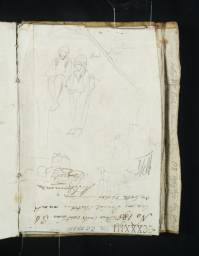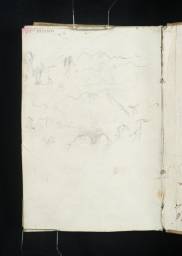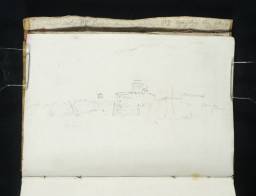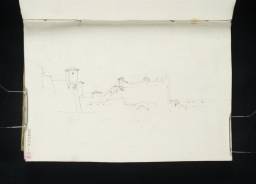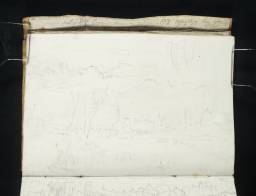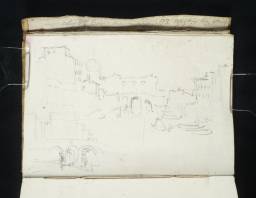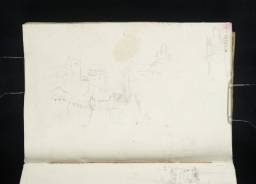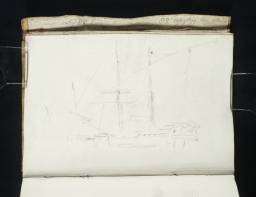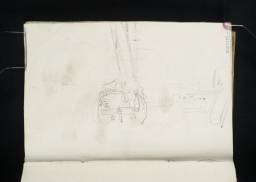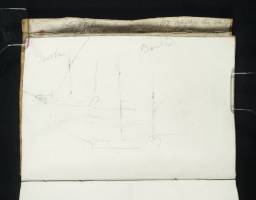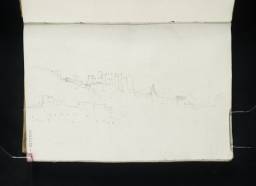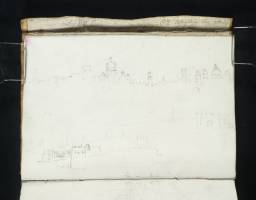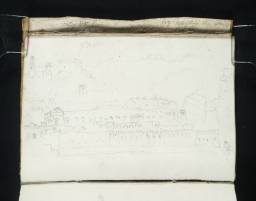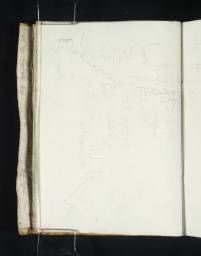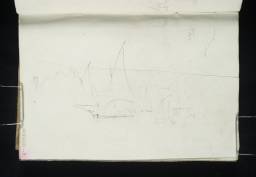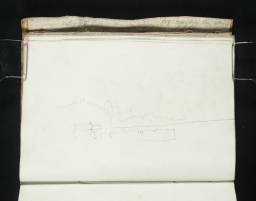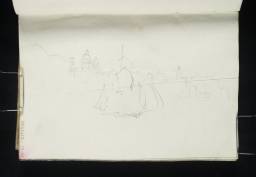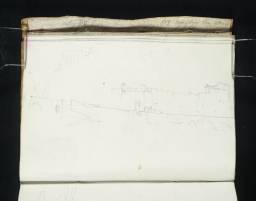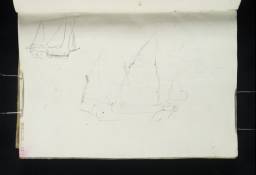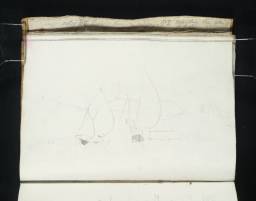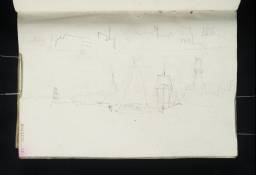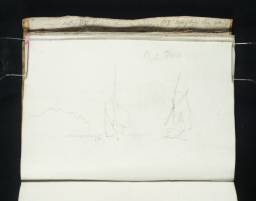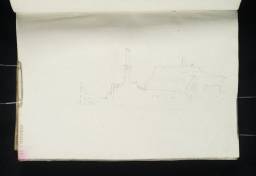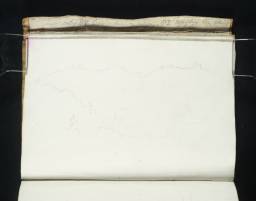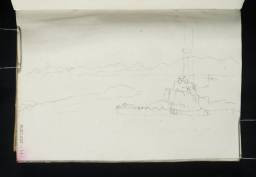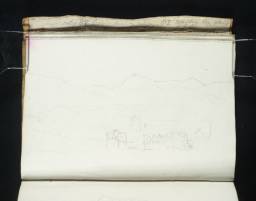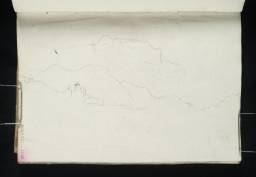Turner Bequest CCXXXIII 1–94a
Sketchbook with boards covered with yellowed parchment, with trimmed front flap protruding c.10 mm; bellows-type pockets front and back
94 leaves and paste-downs of slightly ‘blued’ white lined wove paper, approximate page size 144 x 96 mm; edges washed in mottled blue-green
Possibly made by the Italian paper manufacturer Banolda, based in the Veneto region; watermarked with a unicorn and flag and countermarked ‘G B | B’
Inscribed in red ink by John Ruskin ‘R. Genoa & Florence’ on front cover, towards top right
Stamped in black ‘CCXXXIII’ on front cover, top right
Numbered 195 as part of the Turner Schedule in 1854 and endorsed by the Executors of the Turner Bequest inside front cover (D40997), with further notes by its assessors on adjacent flap
Inscribed in pencil ‘CCXXXIII’ inside front cover
Stamped in black ‘CCXXXIII’ inside front cover
94 leaves and paste-downs of slightly ‘blued’ white lined wove paper, approximate page size 144 x 96 mm; edges washed in mottled blue-green
Possibly made by the Italian paper manufacturer Banolda, based in the Veneto region; watermarked with a unicorn and flag and countermarked ‘G B | B’
Inscribed in red ink by John Ruskin ‘R. Genoa & Florence’ on front cover, towards top right
Stamped in black ‘CCXXXIII’ on front cover, top right
Numbered 195 as part of the Turner Schedule in 1854 and endorsed by the Executors of the Turner Bequest inside front cover (D40997), with further notes by its assessors on adjacent flap
Inscribed in pencil ‘CCXXXIII’ inside front cover
Stamped in black ‘CCXXXIII’ inside front cover
Accepted by the nation as part of the Turner Bequest 1856
Exhibition history
References
Turner used this sketchbook during his second major tour of France and Italy in 1828–9, as one of eight sketchbooks associated with this journey (see the overall tour Introduction). Chronologically, it is the third book in the sequence. As implied by the title, it covers a stretch of the artist’s outward journey to Rome between Genoa and Florence. Finberg applied this title in his 1909 Inventory of the Turner Bequest, which he derived from the customary endorsement on a separate wrapper (among the majority since lost) by John Ruskin, who first sorted and categorised the Turner Bequest: ‘Genoa & Florence, not good, but of some interest.’ Ruskin also added the red ink note ‘R. Genoa and Florence.’ on the front cover.1
The book, likely made locally and bought in Genoa (see the technical notes below), follows on from the Lyons to Marseilles and Marseilles to Genoa sketchbooks (Tate; Turner Bequest CCXXX and CCXXXI), catalogued here by the present author and Nicola Moorby. It also overlaps with the territory covered by the Coast of Genoa sketchbook (Turner Bequest CCXXXII), once attributed to the 1828 tour but since reallocated to a journey undertaken by Turner in 1838: see the relevant section by Hayley Flynn in the present catalogue.
The trajectory covered by this sketchbook extends to around 150 miles of coastline and inland roads, a route that offered Turner considerable topographical richness and variety. He later commented on these features of the landscape when writing to his friend, the artist George Jones, from Rome on 13 October 1828: ‘Genoa, and all the sea-coast from Nice to Spezzia is remarkably rugged and fine; so is Massa.’2 These striking visual contrasts are notable features of the sketchbook, which encompasses the major port cities of Genoa and Livorno; the architectural gems of Pisa and Florence; the rugged Ligurian coastline of the Riviera di Levante, dotted with small fishing villages; and the rolling hills of Tuscany. Among the locations included in Turner’s busy itinerary are Genoa, Nervi, Sori, Recco, Camogli, the Portofino promontory, Santa Margherita Ligure, Rapallo, La Spezia, the River Magra, Avenza, Carrara, Massa, Pisa, Livorno and Florence.
Given the topographical variety encountered by Turner, this is naturally a sketchbook of stark contrasts, ranging from detailed architectural surveys to roughly rendered landscapes. Among the former category are studies of the towers, fortifications and ecclesiastical buildings Turner observed in the four major cities of Genoa, Livorno, Pisa and Florence. These compositions were comparatively time-consuming to produce, suggesting a longer stay in these locations: for comprehensive listings, see folio 6 verso (D21423) for Genoa, folio 68 verso (D21542) for Livorno, folio 31 recto (D21472) for Pisa, and folio 2 verso (D21415) for Florence. Detailed city views are interspersed with schematic outlines of coastal landscapes and mountain ranges in Liguria and Tuscany, likely executed at a swift pace while on the move. Many examples would be difficult to pinpoint geographically, were it not for the artist’s scrawled annotations confirming a location. Many of the views captured in this sketchbook required distant or elevated vantage points. Turner was adept at seeking out prime positions – whether along high coastal roads, hilly slopes, or even from out to sea. Panoramas often took precedence, and to this end he routinely rotated the sketchbook horizontally to encompass a wider view; a hundred such examples are contained in the present sketchbook. Equally, Turner also worked at ease with the sketchbook turned upright and upside down, often cramming multiple studies into a single page and filling the margins with thumbnail details.
Occasionally, the dizzying array of scales and perspectives in this sketchbook makes it difficult to establish Turner’s mode of transport at each stage of the journey. He appears to have toured the harbour of Genoa by boat, a mode of transport he also used for stretches of the Ligurian coastline. A further area of uncertainty is the sequencing of his visits to Pisa and Livorno, and the route chosen for the onward journey to Florence: Turner may have reached Livorno by boat before travelling inland to Pisa and Florence, or approached Pisa via Massa before visiting Livorno and Florence. These difficulties of interpretation are exacerbated by the frequently random ordering of the locations. The title Genoa and Florence, rather than ‘Genoa to Florence’, is apposite; broadly speaking, the views of Genoa are concentrated in the first quarter of the sketchbook, while the views of Pisa, Livorno and Florence appear in the last third. However, this overarching itinerary is continually disrupted by the seemingly random appearance of towns and cities that fall outside the sequence. This lack of uniformity is a reminder of the practical functions of the sketchbook, which Turner habitually used while on the move. Eager to record a transitory view, he likely retrieved the sketchbook from his pocket and hastily drew on the first available page he could find.
Finberg’s 1909 Inventory of the Bequest tended to assign generic titles to the works in this sketchbook, most of which have been revised in the present catalogue with more precise identifications. Ruskin’s typically judgemental endorsement, as noted in full above, concluded dismissively: ‘not good, but of some interest’.3 More recently, Cecilia Powell has revised this assessment; despite many sketches appearing as ‘hasty scribbles or tiny memoranda’, there is nevertheless ‘both variety and interest in Turner’s brief records’.4 They include ‘sketches of towns and stretches of countryside made while travelling; careful drawings of architecture made when he stopped to rest; studies of skies and notes on colours; sketches of peasants at work and of his fellow-travellers’.5 Much of this tour, Powell reiterated, was uncharted territory for the artist: ‘the sight of new areas of France and Italy and the sense of excitement at the beginning of a tour were clearly a strong incentive to sketch so that, perhaps not surprisingly, on Turner’s second visit to Italy it was the journey to Rome, as distinct from his time in Rome itself, that stimulated the majority of his sketching.’6
Technical notes
How to cite
Hannah Kaspar, ‘Genoa and Florence Sketchbook 1828’, sketchbook, November 2024, in David Blayney Brown (ed.), J.M.W. Turner: Sketchbooks, Drawings and Watercolours, Tate Research Publication, February 2025, https://www

